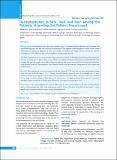Please use this identifier to cite or link to this item:
https://hdl.handle.net/20.500.14356/1486| Title: | Dermatophytes in Skin, Nail and Hair among the Patients Attending Out Patient Department |
| Authors: | Jha, Beena Bhattarai, Sabina Sapkota, Jyotshna Sharma, Manisha Bhatt, Chandra Prakash |
| Citation: | JhaB., BhattaraiS., SapkotaJ., SharmaM., & BhattC. P. (2019). Dermatophytes in Skin, Nail and Hair among the Patients Attending Out Patient Department. Journal of Nepal Health Research Council, 16(41), 434-437. https://doi.org/10.33314/jnhrc.v16i41.1651 |
| Issue Date: | 2018 |
| Publisher: | Nepal Health Research Council |
| Article Type: | Original Article |
| Keywords: | Dermatophytes Dermatophytosis Epidermophyton Tinea Trychophyton |
| Series/Report no.: | Oct-Dec 2018;1651 |
| Abstract: | Abstract Background: Dermatophytosis are the most common types of cutaneous fungal infection seen in human and animals affecting skin, hair and nails caused by dermatophytes. The diagnosis of dermatophytes is based on the clinical observation and laboratory diagnosis by direct microscopic examination and fungal cultures. The present study is undertaken to isolate different type of dermatophytes causing fungal infection. Methods: A prospective cross-sectional study design was used in a total of 90 clinically suspected cases of dermatophytic infection attending the out patient department of Kathmandu Medical College and Teaching hospital (KMCTH). Skin scraping, hair and nail samples were collected from the patients and were processed by direct microscopy and culture using standard protocol. Dermatophytes were identified based on the microscopic arrangement of microconidia and macroconidia. Results: Dermatophytosis was more common in the age group of 21-40 years and was more predominant among male with male to female ratio of 1.7: 1. Among the total clinically suspected cases of dermatophytosis, 53 were positive in direct microscopy and only a total of 20 were positive by culture. Most common clinical type observed in our study was Tinea corporis(25%) followed by Tinea cruris. Trichophyton rubrum(50%) was the commonest aetiological agent in majority of clinical types followed by Trychophyton mentagrophytes(35%). Conclusions: The study highlighted T. corporis followed by T. cruris and T. unguim as the most common clinical pattern of dermatophytosis with a male predominance and 21-40 years being the most affected age group. T. rubram was the most common aetiological agent causing dermatophytosis. Keywords: Dermatophytes; dermatophytosis; epidermophyton; tinea; trychophyton. |
| Description: | Original Article |
| URI: | http://103.69.126.140:8080/handle/20.500.14356/1486 |
| ISSN: | Print ISSN: 1727-5482; Online ISSN: 1999-6217 |
| Appears in Collections: | Vol. 16 No. 4 Issue 41 Oct - Dec 2018 |
Files in This Item:
| File | Description | Size | Format | |
|---|---|---|---|---|
| 1651-Manuscript-7845-4-10-20190221.pdf | Fulltext Article. | 203.18 kB | Adobe PDF |  View/Open |
Items in DSpace are protected by copyright, with all rights reserved, unless otherwise indicated.
